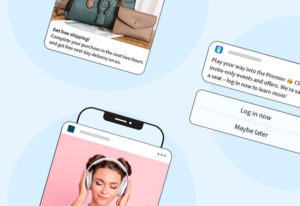Previously, I’ve written about the importance of mobile push notifications in your marketing plan, and how ditching the SDK might be the thing your marketing program needs. Today, I’d like to talk a little bit more about mobile messaging, but with a different channel: SMS.
A Little History
It’s no secret that people love text messages. Developed in the early 1990s, texting quickly rose to popularity due to its ease of use and low cost. It remains, by many estimates, to be the world’s most popular mobile application. And, while down from its peak in 2011, over 1.5 trillion SMS messages are sent within the United States each year.
So it’s obviously popular with consumers, but why should marketers be considering SMS programs in addition to email and mobile push?
- Get the message out: Studies report that users are 35x more likely to open and read an SMS message than an email. With open rates of >98%, SMS are nearly guaranteed to be seen
- Immediate communication: Not only are users more likely to interact with SMS, they are going to see it sooner. The average time to open an SMS message is 90 seconds
- An Interactive Channel: While email reply rates remain low, users are happy to interact with a brand via SMS. In fact, over half of survey respondents stated they would provide product feedback via SMS.
I’m sure I don’t need to convince many marketers on the importance of SMS — nearly all of us use it every day. In my experience helping brands onboard SMS programs, I see two major roadblocks that hold marketers back from sending effective mobile messages: a misunderstanding of how SMS messages are sent, and the lack of vision of how the higher-cost SMS channel would work with their email programs. Let’s tackle those one by one.
How does SMS work?
As I’ve mentioned before, SMS is a decades-old technology that has been built and adapted worldwide for years. Now, while I won’t get into the technical details of how SMS messages are sent (you can check the wiki for that), I will give a high-level overview of the types of numbers marketers can purchase, and what they are for. MessageGears offers two main types of SMS numbers: Short codes and Toll-Free Numbers. Let’s dive in on each:
Short Codes: when you need to send a lot of messages in a short amount of time
A short code is just that — a short 5- or 6-digit number that is capable of sending SMS messages at high volumes within a territory. While these codes originated as a way for brands to be more easily identifiable, they are now the premium product for high-volume SMS sending and the most reliable form of messaging. Short codes are meant to be used if you need to send messages in bulk (burst capacity of dozens or hundreds per second), and are provisioned per territory. This means that if you would like to send SMS campaigns in both the U.S. and the U.K., you would need to provision two different numbers.
Short codes are monitored and regulated through the CTIA, and most activities are guided by the online CTIA guidebook. Although many providers may get you in hot water by sharing your short code to save money, MessageGears prohibits sharing codes and will only ever allow you to message on your code. This means that your short code is recognizable by the consumer to your brand only — a useful way to build consumer confidence in your messages.
Although they are the fastest and easiest way to send SMS (with the lowest messaging fees per message), short codes do have their downsides. Short codes take weeks to provision through cell carriers, and typically have an up-front fee to get started. If you want to get up and running soon, perhaps you should consider a Toll-Free Number.
Toll-Free Numbers: when you want to send messages now
Toll-Free Numbers (TFN) are codes that begin with recognizable 3-digit sequences, and were established long ago for outbound phone communication. However, marketers have recently gained the ability to send SMS messages on these numbers and take less than a day to provision.
TFN are easy to use and are quick to get up and running, but come with caveats of their own. Delivery quality for TFNs may vary, as it is up to the cell carriers to deliver the message as they see fit, and users do not have bulk capacity when sending by TFN. However, TFNs are a great solution if you’d like to send triggered/transactional messages to a small population and are a great toe in the water for many SMS programs.
How to add SMS into your messaging
Although adding SMS into existing marketing programs may seem daunting, it’s actually pretty simple. Consider the following situations:
Shipping or Purchase Alerts — A quick and easy win for marketing groups to introduce SMS is using it to alert the user to when their product has shipped or arrived near them. These are low-touch messages that delight the recipient (who doesn’t want what they ordered?). Easy to then couple with product feedback for establishing a two-way relationship with the user.
Product Feedback — A straightforward way for brands to begin a two-way relationship with their users, asking for feedback on a recent purchase or experience has a high rate of interaction among SMS recipients. Making it simple to leave a rating or a short snippet available on your site also builds trust with your recipient (e.g. “Text back a number between 1-5” followed by “Thanks! Feel free to respond with any thoughts or a quick comment”)
Upcoming Reminders — Another low-touch message great for travel and entertainment brands is to remind users of events they have signed up for that are coming up. It excites the recipient to be reminded of their new event and also gives them a way to respond to the brand with any questions or issues.
Flash Sale — Venturing outside of transactional messaging, alerting recipients to flash sales or events is an easy use case to try to measure bulk messaging response rates. Make text short and calls to action clear to make it obvious to your recipients what the opportunity is and how they can act. Couple with Send Time Designation to ensure that messages always reach recipients at relevant times.
MessageGears wants it to be easy for you to get up and running with your SMS programs. If you have any questions, let us know @messagegears or at sales@messagegears.com.






